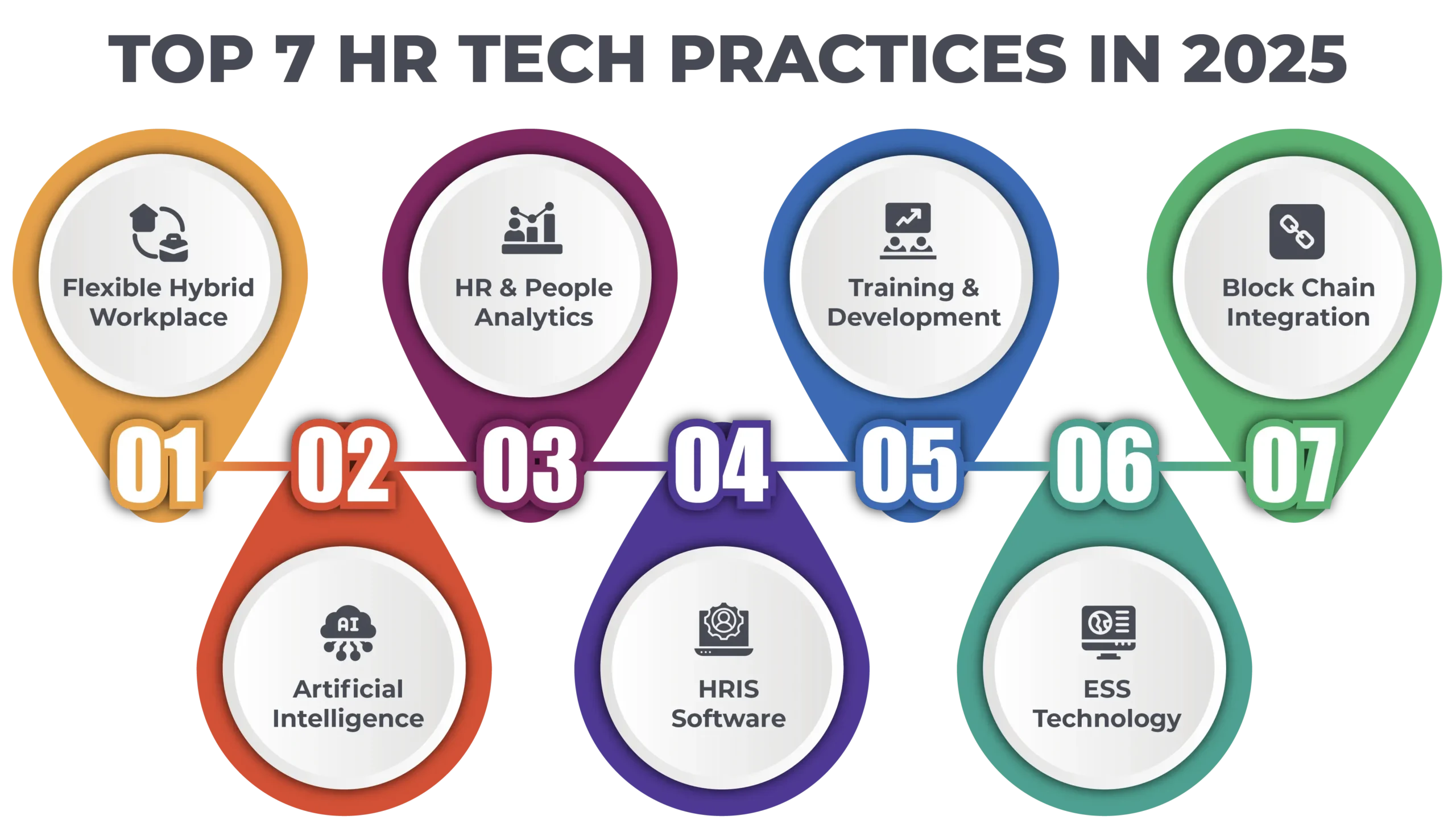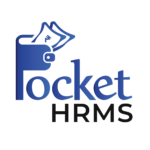
HR Technology
Table of Contents

Reading Time: 7 minutes
What is HR Technology?
Human Resource Technology is a term that defines the overall technologies, including hardware and software, used to improve the future of HR practices and automate essential HR functions. HR technology like HR management software, helps HR professionals smoothen their time-consuming, repetitive HR tasks, including:
- Documentation
- Shift Management
- Upskilling and Development
- Communication Services
- Talent Management
- Compensation Management
- Data Management
Top 7 HR Tech Practices in 2026
Aligning with the continuous evolvement of Human Resources technologies, the overall company work process is updated accordingly. Some new trends have come already, those are,

1. Flexible Hybrid Workplace
After the COVID-19 pandemic, the tendencies of a hybrid work culture are evolving gradually. People will love it, as they enjoy the flexibility in the work atmosphere and work-life balance. On the other hand, it becomes very precious for employers as they can easily reach candidates beyond their limitations without thinking about any geographical restrictions.
HR tech trends carry outstanding features and functionalities that enable employers to accept the flexible hybrid work culture in the workplace.
The tech practices assist HR leaders in introducing a real-time collaboration platform where one can directly communicate with team members or managers, virtual communication tools, cloud-based HRIS, and workspace management solutions for remote and onsite employees. Overall, this leads to a seamless work experience and employee engagement regardless of location.
2. Artificial intelligence(AI)
In 2025, artificial intelligence and related machine learning are some of the most trending practices in recent times. AI technologies streamline the future of the hr by introducing the automation process in HR practices. The practices eliminate repetitive tasks, improve workforce analytics, auto-update accurate reports, etc.
Moreover, AI-powered chatbots and machine language algorithms simplify overall HRMS solutions, including recruitment, onboarding, and performance management, and provide control over HR professionals who take the initiative in strategic decision-making and building a thriving work environment.
3. HR and People Analytics
Employers often face the challenge of analyzing data and making business decisions. However, with the comprehensive nature of HR analytics, these decisions become more informed and secure, from candidate search to employee offboarding. The analytics also provide valuable insights into the people management process, demonstrating HR’s efforts as part of an effective and modern HCM strategy.
4. HRIS software
An on-trend HR technology ensures HRIS practices in the workplace. Now, what is the definition of HRIS? It is a human resource information system, a set of tools that A human resources information system maintains and manages detailed employee information and human resources-related policies and procedures. Human resource information software nowadays is a key part of the HR technological strategies that boost employee management and solutions related to employee data, payroll, security, benefits, etc. Moreover, the system helps HR in making data-driven decisions through the built-in automation process. Some trends in HRIS software for 2025 include,
- AI and machine language
- Performance management
- Compliances and regulation
- Cloud-based software assistance
5. Training and Development
Employee training and development are some of the challenging tasks that HR should excel at. Proper training leads to employee engagement, which is reflected in employee retention. With its digital learning platforms, HR technology ensures affluent course resources for employees, automates their workflows, and supports employees seeking professional growth. The technological advancements enable a culture of constant improvement, adapt to new skill requirements, and foster a forward-thinking, optimistic approach to training and development.
6. ESS Technology
Employee self-service portals or ESS assistance is a major trend in human resources technology and is expected to continue in the coming years. ESS portal is a set of tools ensuring employees control HR practices and solutions. With the ESS assistance and updating their professional document on the HRMS platform, they can evaluate their performance, check their attendance and even directly communicate with the higher authorities without seeking HR permission. Employers also use HR tech to automate processes and avoid daily repetitive tasks like documentation, data verification, storing them, etc.
7. Block Chain Integration
HR technology assists in integrating the blockchain mechanism within the workforce. First, let’s discuss the blockchain mechanism. It is a digital ledger that secures peer-to-peer transactions, stores and analyses data using decentralized techniques, and stores every data transaction record as a block on the blockchain for future use.
HR technology, with its high-end blockchain mechanism, ensures efficient and reliable data management. Its end-to-end encrypted data protects sensitive information, confirms the authenticity of employee documents, and ensures compliance with privacy regulations, thereby enhancing the productivity of IT professionals.
Why do Employers use Human Resources Technology in HR?
In the previous section, we discussed the top trending HR technology in 2025; now, queries may be coming about how employers can use HR technology to improve workforce success and achieve business profit.
➔ Enhanced Productivity
HR technology comes with trending HR practices, which involve the introduction of artificial intelligence, cloud assistance, and data analytics to end-end ESS support. The overall HR technological practices not only help the employees engage but also assist the employers in maintaining a balanced work environment, ultimately leading to enhanced productivity and employee retention.
➔ Support for Talent Strategy
HR technology initiates a high-end automation process that delivers data-driven insight to track employee skills, performance, and development with the assistance of talent management systems. It provides real-time employee performance reports, enabling a clear understanding of top performance and identifying employees who need further training. With the aid of HR technology, employees can create personalized career growth plans and streamline their succession planning. This strategic alignment with future productivity and better career growth underscores the long-term benefits of HR technology.
➔ Deliver Actionable Insight
Updated HR technology aids employers in collecting and analyzing a vast amount of employee data, including performance metrics, engagement levels, attendance levels, and turnover rates. It delivers actionable employee data insight by aligning with advanced analytic tools and AI assistance.
Moreover, HR technology understands trends, analyzes employee-related issues, and anticipates future workforce needs.
➔ Smooth Ecosystem Connectivity
Updated HR technology aids employers in collecting and analyzing a vast amount of employee data, including performance metrics, engagement and attendance levels, and turnover rates. It delivers actionable employee data insight by aligning with avant analytic tools and AI assistance. Moreover, HR software in India plays a crucial role in understanding employee-related issues, making you feel understood and empathized within your workforce.
➔ High-end Compliance Support
Every year, labour laws and compliances are updated to keep up with the ever-changing Industrial Employment (Standing Orders) Act. HR technology is a powerful tool for employers, providing high-end compliance support and changing labour laws. It is particularly effective in risk management, as it maintains accurate records and eliminates the risk of law misuse and penalties.
HR technology ensures that HR processes align with current laws and standards, covering everything from payroll to employee benefits and data management.
➔ Robust Security and Privacy
HR uses the trending HR technology and follows practices that identify and enhance the workforce’s robust security and privacy. The process includes end-to-end employee data encryption, multifactor authentication and related access control, secure cloud storage, and data protection regulations using GDPR.
Things you Should Perform While Implementing HR Technology
Implementing HR technology correctly can be tricky, though if you know the process of implementing HR technologies, you can easily stay on trend with updated HR technologies. You should perform the highlighted points before implementing the HR technology.
1. Research
Selecting the right vendor and choosing proper technological practices is the most challenging task of all. You must consider your company’s requirements when choosing software. You can choose between two main categories for HR software: on-premise and cloud software. In the case of large entities, employers can select the on-premises cause it offers numerous options for customizing more modules. Conversely, the cloud-based categories are more suitable for small midrange enterprises as they match fit into their budget.
2. Choose Criteria
Before initiating HR technology practices, defining your specific criteria and requirements is crucial. These may include factors such as scalability, user-friendliness, and integration capabilities. Once you understand what you need, you can ask for a demo and free trial and check whether the strategies suit your brand enhancement. After understanding the features and functionalities provided and their efficiency in your workforce, you can opt for one.
3. Training
Before selecting the software, you should know whether the vendor provides proper training. Learning the lessons and manual on the usage and other tools is essential to get the most out of your technology. You must include every stakeholder in the training so that maximum questions are answered. When implementing a new tech, try finding a vendor to assist you in training and providing ongoing support, also known as ‘handholding ‘, throughout the project.
4. Select Timing
Selecting proper timing is essential while accepting the trending practices of HR technologies. If you run a SaaS-based system, aligning with the practices will take a little time. Besides, implementing during the company off-season is always advised to understand and manage downtime.
5. Implement in Segments
Employers can find transitioning to new HR technology trends complex. However, the HR department can comfortably adapt to the changes by starting with a few key modules and gradually scaling up. This approach can help alleviate concerns and ensure a smoother transition.
6. Data migration
Since implementation has just concluded, you must start by transferring all your existing HR data from your current system into the new software. This will create a backup of all your confidential assets, information, and data to prevent any loss. The software vendor can help you with a smooth data migration.
7. Testing
Testing is the key focus after a successful and lengthy implementation process. Before importing the backed-up data into the newly implemented system, it is crucial to thoroughly test it with demo inputs. This proactive approach will help in minimizing resource and time wastage. Every aspect of usage and requirement needs to be meticulously tested to counter every possible error, underscoring the importance of your role in this process.
8. Managing Downtime
Unscheduled downtime is a surefire way to sabotage a company’s workflow. Here, the downtime occurs due to the implementation of new software. Downtime without a clear plan could incur serious problems. Downtime management should be taken into consideration when planning to implement the software. Seasons are a feasible time to implement efficient training, too.
At the End
In 2025, HR technology will rapidly enhance the employee experience by involving AI-driven insights, personalized development, and seamless remote work integration. Along with it, different cutting-edge tools will also boost upcoming tech trends. Furthermore, enabling employee wellness support, smooth employer-employee relationships, and work transparency are becoming essential and driving more strategic and compassionate HR practices, showing that the well-being of employees is a top priority.







